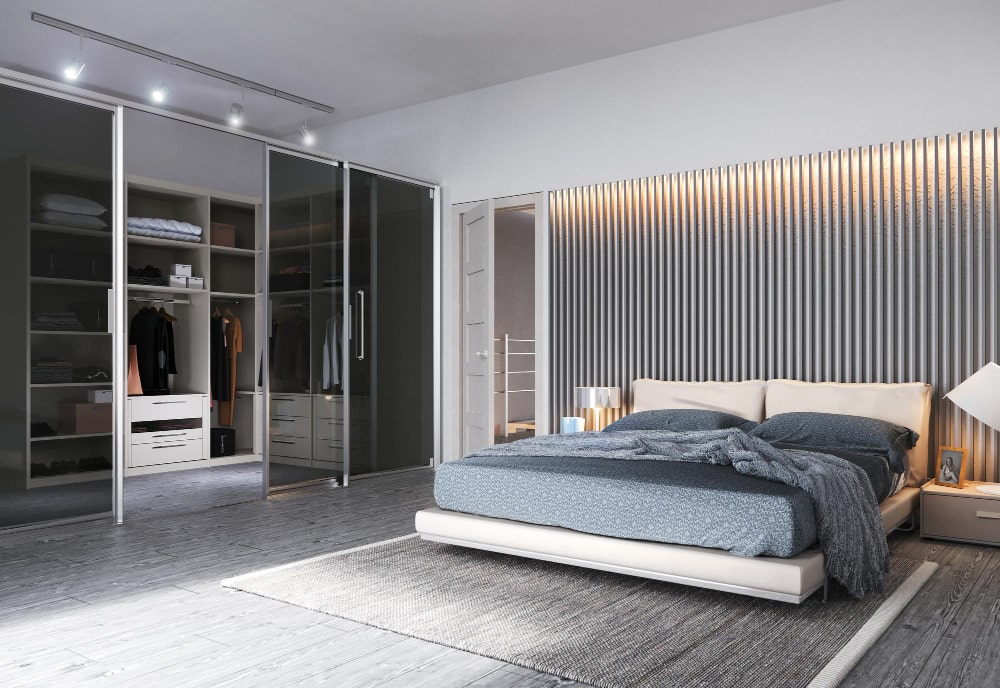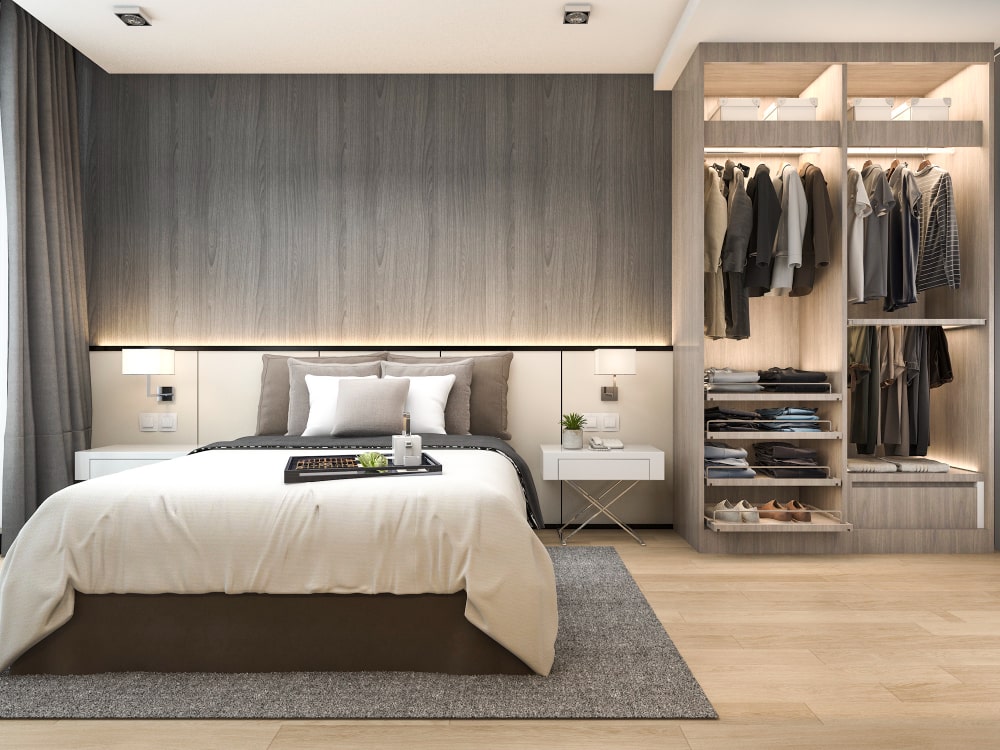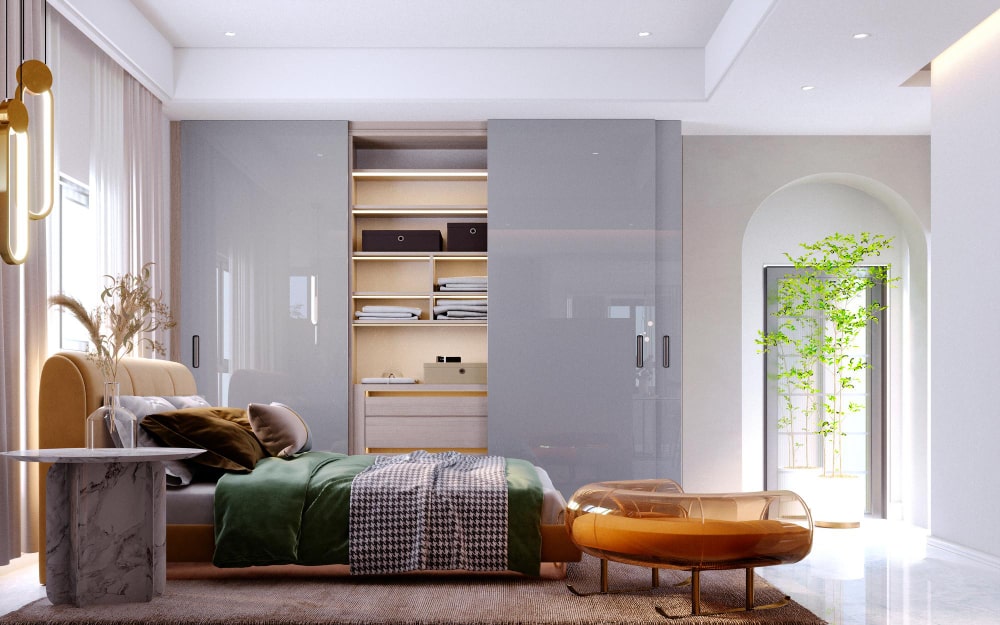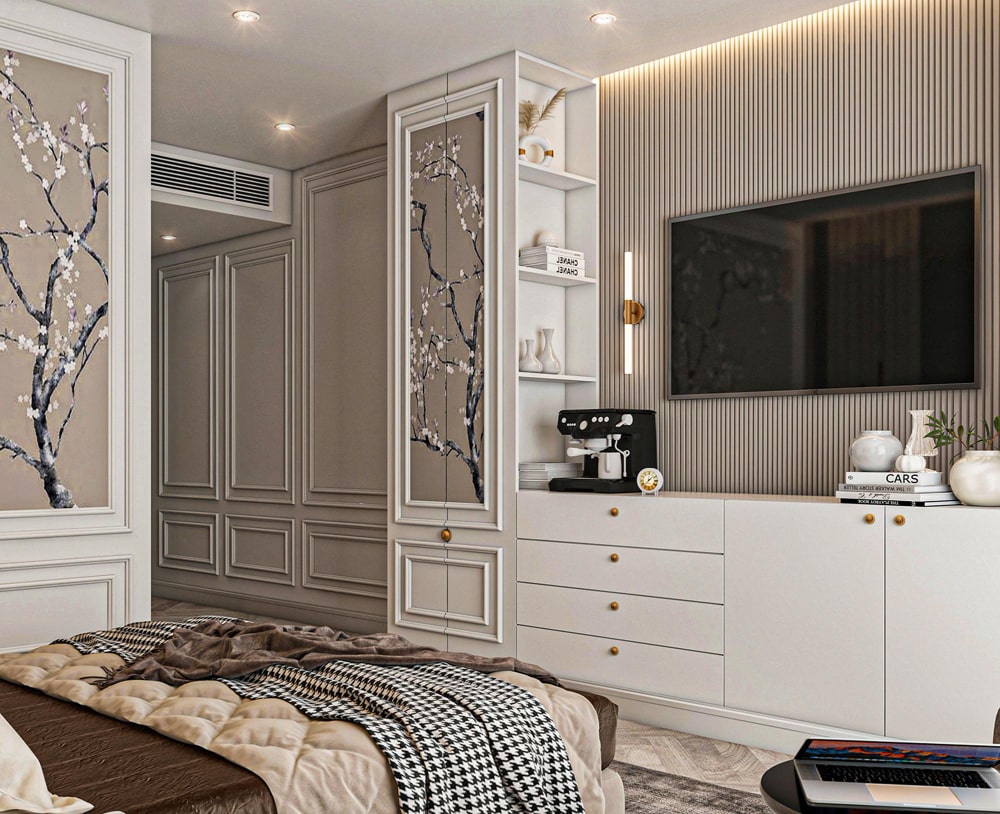
Ever feel like your bedroom wardrobe is bursting at the seams but you just can’t part with any of your clothes or shoes? We’ve all been there. The good news is, there are some clever bedroom wardrobe design solutions that can give you more storage space without sacrificing style. Modern wardrobes featuring sliding doors, hidden compartments, and built-in dressing tables are the answer to your storage woes.
Designing a bedroom wardrobe requires careful consideration of both functionality and aesthetics. A well-designed wardrobe can serve as a stylish storage solution while complementing the overall design of your bedroom. In this article, we will explore various aspects of wardrobe design, including modern wardrobe design, sliding wardrobe design, wardrobe with dressing table design, and designer wardrobe options.
1- Understanding the Importance of Right Design of Bedroom Wardrobes
- Functional Storage Solution: A wardrobe serves as a practical storage solution for your clothing, accessories, and personal belongings. It helps keep your bedroom clutter-free and organised, allowing you to find and access your items easily. A well-designed wardrobe maximises the use of available space, providing dedicated compartments for different types of clothing and accessories.
- Organisational Benefits: A wardrobe with efficient storage features, such as hanging rods, shelves, drawers, and shoe racks, enables you to categorise and arrange your belongings systematically. This organisation saves time and effort when dressing up and ensures that your clothes remain wrinkle-free and in good condition.
- Enhancing Aesthetics: Apart from its functional aspects, a bedroom wardrobe contributes to the overall aesthetics of the room. The design, materials, and finishes chosen for the wardrobe can significantly impact the visual appeal of the bedroom. A well-designed wardrobe can elevate the style and ambiance of the space, adding a touch of elegance and sophistication.
2- Different Type of Bedroom Wardrobes
1- Modern Bedroom Wardrobe

When it comes to modern wardrobe design, sleek and minimalist styles are gaining popularity. These designs focus on clean lines, simplicity, and a streamlined appearance. They often feature smooth surfaces and handle-less doors, creating a seamless and contemporary look.
Incorporating mirrors and lighting into the wardrobe design is another trend that enhances the modern aesthetic. Mirrors not only serve a practical purpose for getting ready but also create an illusion of more space and reflect light, making the room appear brighter and more spacious. Lighting fixtures inside the wardrobe, such as LED strips or spotlights, add a touch of luxury and ensure proper visibility of your clothing and accessories.
Customisation and modular options are essential elements of modern wardrobe design. With customisable interiors, you can create storage compartments tailored to your specific needs. Modular wardrobes allow you to mix and match different units, such as shelves, drawers, and hanging rods, to create a personalised storage solution that optimises space utilisation.
2- Sliding Bedroom Wardrobe

For rooms with limited space, sliding wardrobes offer a practical and space-saving solution. Unlike traditional hinged doors that require additional clearance space, sliding doors glide smoothly along tracks, maximising floor space in the room.
The smooth sliding mechanism of these wardrobes ensures effortless operation, and some even come with soft-closing features, providing a gentle and silent closing action. Sliding wardrobes come in various designs and finishes, allowing you to choose a style that matches your bedroom decor.
The versatility of sliding wardrobe design is another advantage. They can be customised to include a combination of shelves, drawers, and hanging rods, offering ample storage for all your clothing and accessories. Additionally, you can incorporate features like built-in shoe racks or pull-out trays for added convenience.
3- Bedroom Wardrobe with Dressing Table

Combining functionality and style, a wardrobe with a dressing table design brings together two essential elements of a bedroom. This design integrates a dedicated space for grooming and getting ready within the wardrobe itself, optimising space utilisation in the room.
A wardrobe with a dressing table often includes an integrated mirror, allowing you to have a complete vanity area without the need for additional furniture. This setup offers convenience and saves space, especially in smaller bedrooms.
Furthermore, these wardrobes provide additional storage for makeup, skincare products, and accessories. Drawers and compartments designed specifically for storing cosmetics and grooming essentials ensure that everything is neatly organised and easily accessible.
4- Designer Bedroom Wardrobe

If you’re looking to make a bold statement with your bedroom wardrobe, a designer wardrobe is the way to go. Designer wardrobes are characterised by their unique and artistic designs that go beyond conventional styles.
These wardrobes often feature creative patterns, textures, or finishes, adding a touch of artistic flair to your bedroom. They can become the centrepiece of the room, showcasing your personal style and creating a visually stunning focal point.
Designer wardrobes are crafted with utmost attention to detail, using premium materials and exhibiting exquisite craftsmanship. These high-quality materials not only enhance the aesthetics but also ensure durability and longevity. To build one of these, it would be best to hire a professional rather than doing it yourself. Sometimes their experience and technique can do wonders to the design of your wardrobe.
3- Factors to Consider When Designing a Bedroom Wardrobe
Designing a bedroom wardrobe requires careful consideration of various factors to ensure a functional and visually pleasing result. Here are some key factors to keep in mind:
- Available Space and Room Layout: Before designing a wardrobe, assess the available space in your bedroom and consider the room layout. Take accurate measurements of the dimensions, including the height, width, and depth of the area where the wardrobe will be placed. This information will help you choose a wardrobe design that fits perfectly into the available space.
- Storage Requirements and Organisation: Consider your storage needs and the organisation of your wardrobe. Assess the quantity and types of clothing, accessories, and personal items you need to store. Determine if you require more hanging space, shelves for folded items, drawers for smaller items, or specific compartments for shoes or accessories. This evaluation will guide you in selecting the right interior layout and storage features for your wardrobe.
- Design Cohesion with the Bedroom: Ensure that the design of your wardrobe complements the overall style and theme of your bedroom. Consider the existing furniture, colour scheme, and decor elements to create a cohesive and harmonious look. Whether you opt for a modern, traditional, or eclectic design, the wardrobe should blend seamlessly with the rest of the room.
- Budget Considerations: Establish a budget for your wardrobe design project. Determine how much you are willing to invest in materials, customisation options, and professional assistance if needed. Research different options and price ranges to find the best balance between quality and affordability.
4- Step-by-Step Guide to Designing a Bedroom Wardrobe
Now that you have an understanding of the various aspects of wardrobe design, follow this step-by-step guide to create your perfect bedroom wardrobe:
- Assessing Your Needs: Determine your storage requirements and the specific items you need to accommodate in your wardrobe.
- Taking Accurate Measurements: Measure the available space in your bedroom, including height, width, and depth, to determine the dimensions for your wardrobe.
- Choosing the Right Style and Materials: Select a wardrobe style that aligns with your bedroom design and choose high-quality materials that ensure durability and aesthetics.
- Customising the Interior Layout: Based on your storage needs, customise the interior layout of your wardrobe by incorporating shelves, drawers, hanging rods, and specialised compartments.
- Incorporating Functional Features: Consider additional functional features like shoe racks, pull-out trays, or built-in lighting to enhance the functionality and convenience of your wardrobe.
- Considering Lighting and Accessories: Install appropriate lighting fixtures inside the wardrobe to improve visibility and make it easier to locate items. Additionally, accessorise the exterior with handles or knobs that complement the overall design.
- Hiring Professional Help if Needed: If you require assistance with the design, customisation, or installation process, consider consulting with professional interior designers or wardrobe specialists.
By following these steps, you can create a well-designed bedroom wardrobe that meets your storage needs while adding style and functionality to your space.
5-Making your Bedroom Wardrobe more Dynamic
A-Space-Saving Sliding Bedroom Wardrobe Doors
Sliding wardrobe doors are a space-saving solution for small bedrooms or closets. Instead of doors that swing open into the room, sliding doors glide smoothly along a track, saving valuable floor space.
- Look for sliding doors that are mirrored or have full-length mirrors. The reflective surface will make your room appear more open and spacious.
- Consider sliding doors with built-in storage cabinets and drawers. This provides extra storage without taking up more floor area. You can store folded clothes, accessories, jewelry and more in the integrated drawers and cabinets.
- For easy access, choose sliding doors that slide along an overhead track. This allows the doors to slide completely out of the way, giving you full access to your wardrobe. Sliding doors that slide along a floor track may still partially obstruct the wardrobe opening.
- If possible, opt for sliding doors that slide into pockets in the wall. This provides the most open access to your wardrobe and the most streamlined look. However, pocket doors require adequate wall space on either side of the wardrobe.
- Look for high-quality sliding door hardware like ball bearing slides for smooth gliding and to prevent warping. Stainless steel or aluminum tracks and hardware will last longer.
With space at a premium, sliding doors are a stylish storage solution that won’t crowd your room. Open up your living space and keep essentials neatly tucked away behind sliding mirrored or wood doors. Your wardrobe and your square footage will thank you!
B- Maximizing Storage With Drawers and Shelves
When it comes to maximizing storage in a modern wardrobe, drawers and shelves are your best friends.
Drawers are ideal for smaller items like socks, underwear, accessories, and pajamas. Look for wardrobes with deep drawers so you can organize everything neatly. Some wardrobes also have specialized drawers for jewelry, belts, and other accessories.
Shelves, on the other hand, are perfect for folded clothes, shoes, bags, and boxes. Adjustable shelves let you customize the space to fit your needs. For shoes, look for a wardrobe with a slide-out shelf or a section dedicated to shoe storage. For bags and boxes, deep shelves with guardrails help keep everything in place.
If space is limited, consider a wardrobe with pull-out trays and racks. These provide extra storage space without taking up valuable floor area. Pull-out trays are great for smaller items. Pull-out racks can hold clothes on hangers so you can easily browse and access them.
For the ultimate in convenience, look for a wardrobe with built-in lighting, mirrors, and a dressing table. Integrated lighting makes it easy to see inside, while mirrors let you check your outfit. A dressing table provides a place to sit and get ready. With all these features in one wardrobe, you’ll be able to store everything you need and get dressed efficiently each day.
Your modern wardrobe can do more than just store your clothes – with the right design, it becomes a stylish and functional dressing room that simplifies your daily routine. By maximizing storage with drawers, shelves, trays and racks, you’ll gain space for all your belongings and keep your bedroom clutter-free.
C- Adding a Dressing Table Inside the Bedroom Wardrobe
Adding a dressing table or vanity inside your wardrobe is a great way to maximize space while keeping everything neatly organized in one place.
- Choose a Style: Select a dressing table style that matches your wardrobe design. For a modern look, consider a minimalist table with sleek lines and hidden storage. A traditional style with decorative accents may complement a classic wardrobe better. Measure the available space to determine the ideal size and shape.
- Add Seating: A stool, bench or chair in front of the dressing table provides a place to sit while doing your makeup or hair. Look for seating with a backrest for comfort and support. For extra storage, choose a bench with lift-up seat storage or drawers underneath.
- Include Proper Lighting: Well-lit mirrors are essential for a dressing table. Install wall sconces on either side of the mirror or a strip light along the top. Dimmer switches allow you to adjust the brightness. For the best illumination, place the lights at eye level on both sides of the mirror.
- Add Drawers and Cabinets: Extra storage in the form of drawers, cabinets and compartments keep all your accessories and beauty products organized and within easy reach. Look for a dressing table with different sized drawers to store everything from makeup brushes to hair dryers. Cabinets with doors hide clutter and keep dust away from your items.
- Charging Station: These days, many beauty tools like electric toothbrushes, flat irons and blow dryers need to be recharged. Include built-in USB charging ports in your dressing table design so you can power up your devices right where you use them. A cord organizer or tray keeps charging cables neat and off the tabletop.
A well-designed dressing table tucked within your wardrobe creates a dedicated space for your morning and evening routines without taking up extra floor space in your room. With the right features and storage solutions, you’ll have everything you need to get ready at your fingertips.
6- Choosing Wood or Laminate for Your Wardrobe
When designing your modern wardrobe, one of the biggest decisions you’ll make is whether to use wood or laminate for the doors and drawer fronts. Each material has its pros and cons, so consider your needs and style preferences to determine the best choice for your space.
- Wood: Wood is a timeless, natural material that can make a wardrobe feel warm and luxurious. Popular options for wardrobes include oak, maple, and cherry. Wood doors and drawers are durable and long-lasting but tend to be more expensive, especially for high-quality hardwoods. Wood also requires more maintenance to keep looking its best, like occasional oiling, staining or painting. However, the natural wood grain provides a one-of-a-kind beauty that many homeowners love. Wood bedroom wardrobe is definitely a great choice.
- Laminate: Laminate, like melamine or thermofoil, consists of a plastic coating over particleboard or MDF. Laminate wardrobe doors and drawers are very affordable, low-maintenance, and resistant to scratches, stains and water damage. Laminate comes in a wide range of styles, colors and finishes, from wood grain prints to solid colors to metallic accents. However, laminate may not last as long as wood and can start to peel, scratch or warp over time. Laminate also lacks the natural warmth and character of real wood.
For many, the choice comes down to balancing your budget with your design priorities. If you want an eco-friendly, high-end look and don’t mind the extra maintenance, wood bedroom wardrobe is an excellent choice. If affordability and low-maintenance are more important, laminate doors and drawers will suit you well. You could also opt for a combination, with wood for the doors to get the look you want, and laminate for the drawer fronts to save on costs. Think about how long you plan to keep the wardrobe and how much use it will get to determine whether wood or laminate is the better investment for your needs.
7- Wardrobe Lighting Options to Consider
When designing your wardrobe, don’t forget about the lighting. The right lighting options can make a space feel more open and help you see everything clearly. Here are some wardrobe lighting ideas to consider:
A- Overhead Lighting
Overhead lighting, like recessed or surface-mounted fixtures, provides general illumination for your wardrobe. LED strip or puck lights are easy to install and provide a modern look. For smaller wardrobes, a single centered fixture may be enough. In larger walk-ins, space multiple fixtures evenly to avoid shadows.
B- Task Lighting
For detailed tasks like selecting outfits or applying makeup, consider adding task lighting, such as:
- Wall sconces on either side of a mirror. Sconces provide direct light without taking up space on your vanity or countertop.
- Under-cabinet lighting. LED strip lights installed under cabinets or shelves provide direct light where you need it.
- Table and floor lamps. Freestanding lamps let you direct the light where you want it. Look for adjustable lamps that can be pointed at specific areas.
C- Natural Light
If your wardrobe has windows, take advantage of natural light during the day by opening blinds or curtains. For wardrobes without windows, you can install:
- Skylights or solar tubes. Skylights and solar tubes channel natural light from the roof into your wardrobe.
- Light shelves. A light shelf installed near the ceiling helps reflect natural light deeper into the space.
D- Dimmers and Switches
Install dimmer switches or multi-switch panels to control your wardrobe lighting. Dimmers let you adjust the brightness, while multi-switch panels make it easy to turn different lights on and off. Place switches near the entrance to your wardrobe for convenience.
With the right combination of overhead, task, and natural lighting, your wardrobe will be a bright, functional space. Don’t leave your wardrobe in the dark—explore these lighting options to find what works best for your needs and style.
Parting Words
So there you have it, a few innovative ways to maximize your wardrobe space and make getting dressed each day a little more enjoyable. Whether you opt for sliding doors, a dressing table, or hidden compartments, thinking outside the box with your bedroom wardrobe design can make a world of difference. Your clothes and accessories are an expression of who you are, so give them a home that reflects your unique style. With some clever storage solutions and a few personalized touches, your wardrobe can transform from a place to simply house your clothes into your own private dressing room and sanctuary. Who knew so much could be hiding behind those closet doors! Open them up and see what inspiration might emerge.
FAQs
1. Can I design a wardrobe on my own, or should I consult a professional?
Designing a wardrobe on your own is possible if you have a good understanding of your storage needs and the necessary measurements. However, consulting a professional can provide valuable insights, expertise, and customised solutions that ensure optimal functionality and design.
2. What are some popular wardrobe materials used in modern designs?
Popular materials used in modern wardrobe designs include wood, laminate, glass, and metal. Each material offers different aesthetics, durability, and price points. Consider your desired style, maintenance requirements, and budget when selecting the material for your wardrobe.
3. Are sliding wardrobes suitable for small bedrooms?
Yes, sliding wardrobes are particularly suitable for small bedrooms as they maximise floor space. Their space-saving design eliminates the need for additional clearance for hinged doors, allowing for better utilisation of the room. Sliding wardrobes are designed to glide smoothly along tracks, making them ideal for tight spaces where swinging doors might be impractical. They provide easy access to your belongings while saving valuable floor space.
4. How can I maintain the cleanliness and organisation of my wardrobe?
To maintain the cleanliness and organisation of your wardrobe, follow these tips:
- Regularly declutter and remove items you no longer use or need.
- Group similar items together, such as tops, bottoms, and accessories, to make them easier to find.
- Utilise storage solutions like baskets, dividers, or drawer organisers to keep smaller items tidy.
- Clean your wardrobe periodically by wiping down surfaces and vacuuming or dusting the interior.
- Implement a regular maintenance routine, such as organising and tidying up your wardrobe once a month.
5. Can I add additional features like a TV unit or a shoe rack to my wardrobe?
Yes, you can customise your wardrobe to include additional features like a built-in TV unit or a dedicated shoe rack. These additions depend on your specific needs and available space. Consult with a professional or explore modular wardrobe options that offer customisation flexibility to incorporate such features seamlessly.

